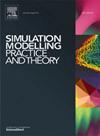基于Adams/MATLAB联合仿真的齿轮齿条传动蔬菜苗传动装置数字孪生模型的开发与评价
IF 3.5
2区 计算机科学
Q2 COMPUTER SCIENCE, INTERDISCIPLINARY APPLICATIONS
引用次数: 0
摘要
蔬菜苗木输送装置的可持续设计和优化控制系统是提高全自动蔬菜苗木移栽机操作速度和精度的关键。将虚拟样机建模方法应用于这些育苗装置的优化设计和控制,在以往的研究中尚未得到充分的探讨。本研究的目标是开发和验证一个数字双胞胎模型,该模型将作为优化设计和控制机器人移栽设备的基础。利用Adams和MATLAB联合仿真,建立了齿轮齿条传动秧苗传动装置的数字孪生模型。结果表明,数字孪生模型与物理样机具有较好的一致性,最大线性定位误差为0.95 mm,最大相对定位误差为3.17,决定系数(R2)值约为1。当幼苗率从90 ~ 140株/mi增加时,角度定位误差在3.73 ~ 7.98°之间。此外,在幼苗传代过程中,观察到苗杯开启机制的精确激活和失活。该数字孪生模型准确地反映了育苗装置的物理模型,可用于设计和控制优化。这种数字孪生模型的潜在未来应用包括提高机器人移植的效率和减轻环境影响。本文章由计算机程序翻译,如有差异,请以英文原文为准。
Development and evaluation of digital twin model for rack and pinion drive vegetable seedling transmission device using Adams/MATLAB co-simulation
A sustainable design and optimized control system for the vegetable seedling transmission device is crucial for enhancing the operational speed and precision of fully automatic vegetable seedling transplanters. The incorporation of virtual prototype modeling for optimizing the design and control of these seedling devices has not been sufficiently explored in prior studies. Goal of this research is to develop and validate a digital twin model that will serve as a foundation for optimizing the design and control of seedling devices used in robotic transplanters. This study presents a state-of-the-art digital twin model of rack and pinion drive seedling transmission device utilizing Adams/MATLAB co-simulation. The findings demonstrate a robust correspondence between digital twin model and physical prototype, exhibiting a maximum linear positioning error discrepancy of 0.95 mm, a maximum relative positioning error of 3.17 and coefficient of determination () values approximately equal to 1. Angular positioning error ranged from 3.73° to 7.98° as seedling rates increased from 90 to 140 seedlings/mi. Furthermore, precise activation and deactivation of the seedling cups opening mechanism was observed during the seedling transmission schedule. This digital twin model accurately represents the physical model of seedling device which can be utilized for design and control optimization. Potential future applications of this digital twin model include enhancing efficiency of robotic transplanters and mitigating environmental impacts.
求助全文
通过发布文献求助,成功后即可免费获取论文全文。
去求助
来源期刊

Simulation Modelling Practice and Theory
工程技术-计算机:跨学科应用
CiteScore
9.80
自引率
4.80%
发文量
142
审稿时长
21 days
期刊介绍:
The journal Simulation Modelling Practice and Theory provides a forum for original, high-quality papers dealing with any aspect of systems simulation and modelling.
The journal aims at being a reference and a powerful tool to all those professionally active and/or interested in the methods and applications of simulation. Submitted papers will be peer reviewed and must significantly contribute to modelling and simulation in general or use modelling and simulation in application areas.
Paper submission is solicited on:
• theoretical aspects of modelling and simulation including formal modelling, model-checking, random number generators, sensitivity analysis, variance reduction techniques, experimental design, meta-modelling, methods and algorithms for validation and verification, selection and comparison procedures etc.;
• methodology and application of modelling and simulation in any area, including computer systems, networks, real-time and embedded systems, mobile and intelligent agents, manufacturing and transportation systems, management, engineering, biomedical engineering, economics, ecology and environment, education, transaction handling, etc.;
• simulation languages and environments including those, specific to distributed computing, grid computing, high performance computers or computer networks, etc.;
• distributed and real-time simulation, simulation interoperability;
• tools for high performance computing simulation, including dedicated architectures and parallel computing.
 求助内容:
求助内容: 应助结果提醒方式:
应助结果提醒方式:


